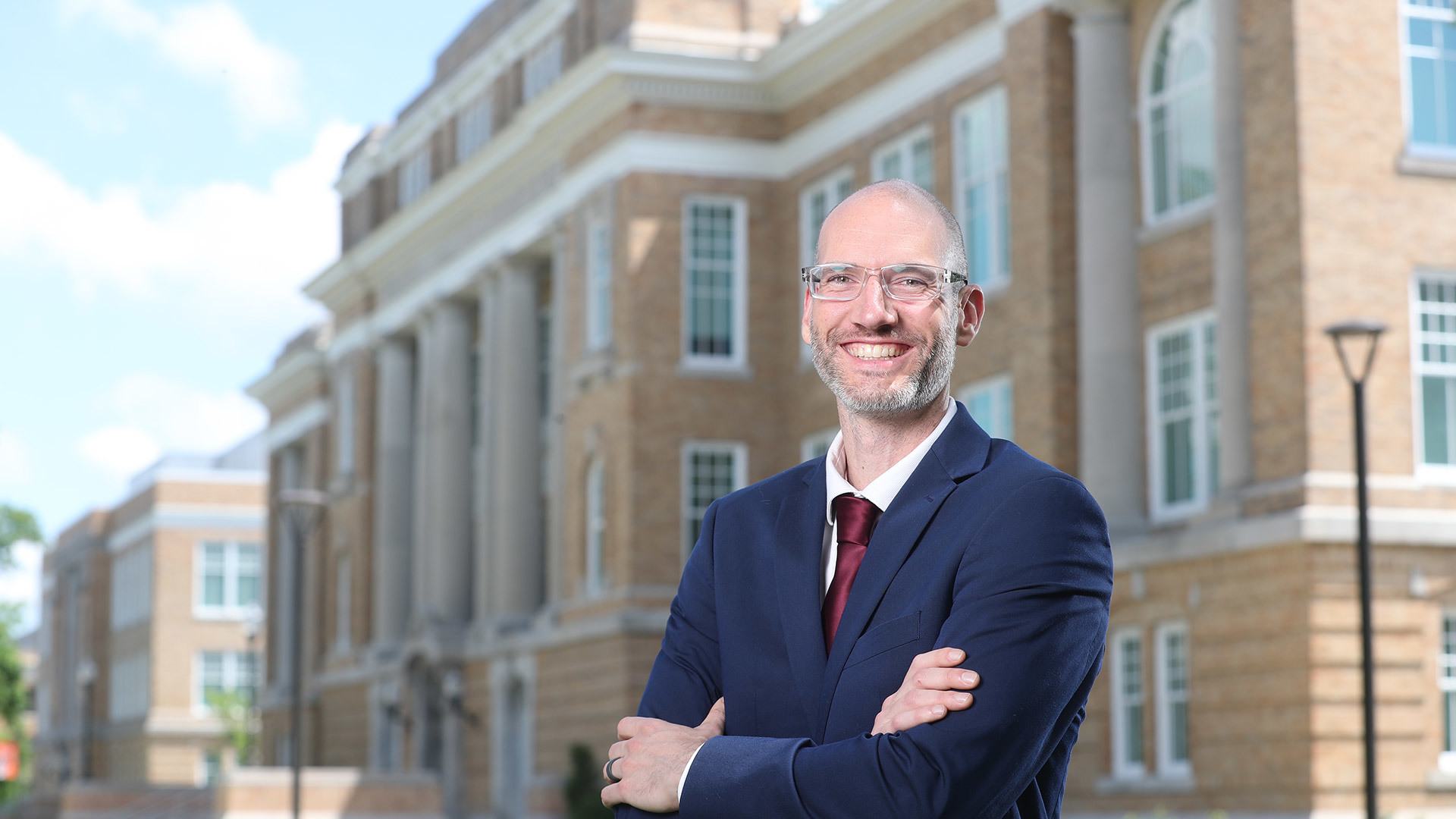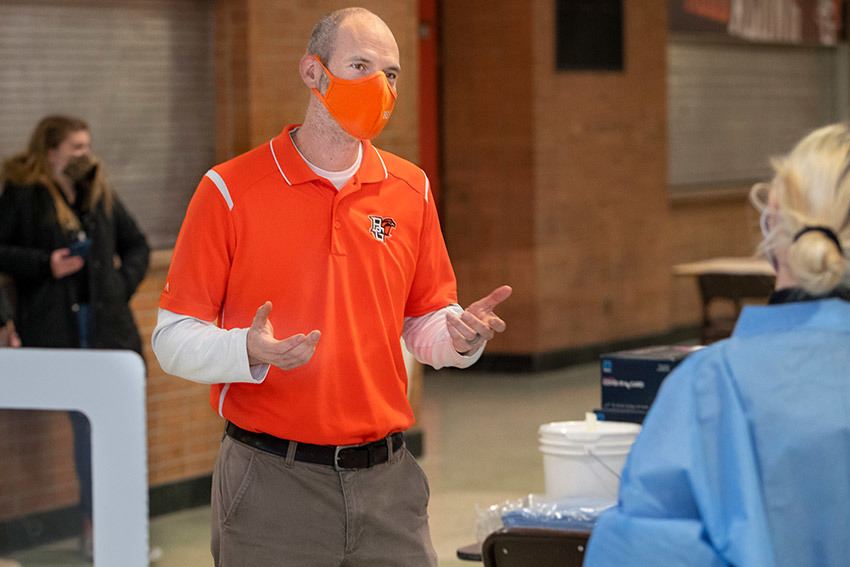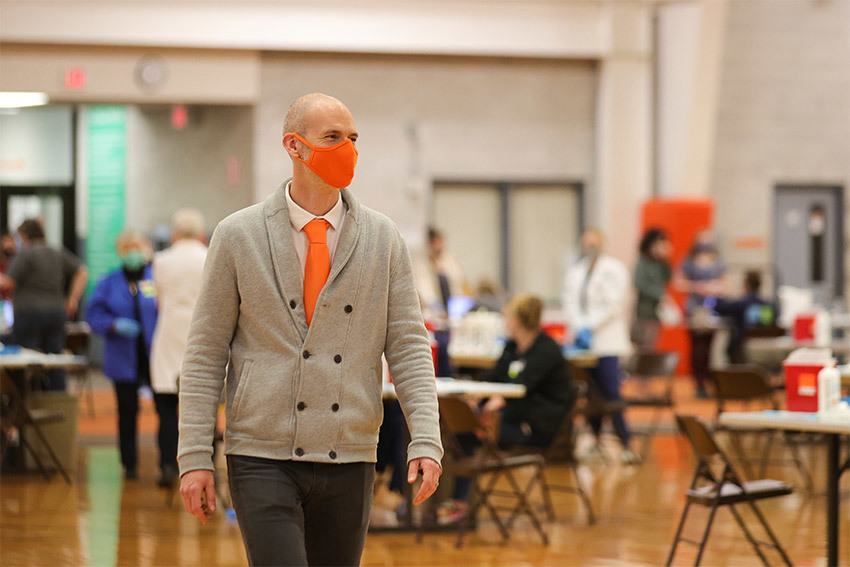How BGSU navigated the global pandemic: A conversation with Ben Batey
When Ben Batey was appointed Bowling Green State University Chief Health Officer in July 2020, he knew he was facing an incredible challenge. Already months into a global pandemic, the former Wood County health commissioner had been navigating the public health crisis for the county and understood what was at stake.
Although he brought years of public health experience, Batey, like everyone, was up against a host of unknown variables and was just weeks away from the start of the fall semester that would bring thousands of students back to campus. Tasked with elevating health and wellness at BGSU, Batey immediately jumped into action.
Through partnerships, Batey spearheaded initiatives that benefited not only BGSU, but the entire community and region, including contact tracing, COVID-19 testing and mass vaccination opportunities. With Batey at the helm of the BGSU COVID-19 Response Team, the University remained open throughout the entire pandemic and conducted 26,882 COVID-19 tests and administered more than 13,327 vaccinations on the Bowling Green campus.
While there is more work ahead, Batey shares his thoughts on the past year and how BGSU moved forward during the global pandemic.
Looking back, how do you reflect on the past year?
We've all lived through this stressful experience and now that we are moving back to a sense of normalcy, it's almost surreal to look back. When we originally started shutting down and sheltering in place at home, I think we all thought we were going to stay home for two weeks, and, if everyone did that, numbers would come down and we would all get back to normal life. The progression of that mindset to the reality that this was going to be much, much longer was a challenge.
We faced so many unknowns throughout the pandemic. Are the hospitals going to be able to hold? Will we have enough personal protective equipment (PPE)? We had testing shortages and early on, test results were taking 10 days. Each step of the way we learned more but faced new obstacles at every turn.
We have learned so much over the past year. Although numbers are trending down and we are returning to a sense of normalcy, from a public health perspective, we are much better positioned to navigate COVID-19 moving forward. We have vaccines, testing kits and proven health and safety guidelines to slow the spread. Even though there is more work ahead, I’m optimistic because of all of the information and readily available resources we have today that we didn’t have a year ago.
How did you face challenges unique to a college setting?
As a residential campus, our community comes from all over, which is different from a county as a whole. We were always committed to keeping BGSU open for our students. There were health implications on both sides - from the virus itself to the social impacts on young people. Trying to navigate both of those pieces equally was a big challenge that was first and foremost always on my mind.
In the early days, it was nonstop - let's just keep at it, keep moving forward, assessing every week, putting up the dashboard, and modifying what we need to. I didn't want to reach a point of such high case numbers at one time that would prompt what some other universities had to do - quarantines across the entire campus, residence halls shut down, classrooms closed. We never wanted to go down that road and, luckily, we never had to.
Every day, we asked, "what is our biggest challenge to be able to move forward and keep things open?" At first, we knew we needed our own contact tracers because as we watched state and county numbers, we knew we were going to have cases here, too. We needed to be able to identify and reach out to those cases even faster than the local health department so we could isolate, contact trace and quarantine to keep outbreaks under control. So, we built a team of student contact tracers that made our response to positive cases much quicker.
Then, our next hurdle was testing. We knew if we couldn't test quickly, we were going to have cases we didn't know about and it would be too late. We worked with the Wood County Hospital and went to Ohio State University and the Ohio Department of Health to consult on the best testing system that would give us the quickest turnaround time with readily available supplies. BGSU helped the Wood County Hospital stand up that testing capability for the community and our students. But we also wanted to be even quicker, so the University invested in a rapid testing structure. Our medical laboratory sciences (MLS) program stepped up and said if you can get the kits, we can test on a large scale.
Every time we'd walk into a challenge with something we hadn't done before, our mentality was let's at least try. All we could do is try it the first time and figure out what didn't work. We'd modify and get better, more efficient and quicker. We just kept doing that over and over again throughout the pandemic.
How was BGSU able to remain open with in-person classes and student experiences throughout the pandemic?
We had an underlying spirit of 'we're going to try'. It was hard, but just because it was hard it did not stop us from attempting it. From a logistics perspective, it may have been easier to stay virtual and not worry about people interacting in person. But we always had the social and mental health impacts on our mind as well and we never felt going entirely virtual was the best path forward for us. We stayed open. We extended our move-in, adjusted where we needed to and had social events for students.
Even though it was harder to say we're going to try and address issues as they arise, that's the path we took. We needed to engage students in person so we said let's do it, and let's do it safely. We got creative and had events outdoors, even in the winter. That was always our approach - it was never, no, we can't do it; instead, it was how can we do it, and how can we do it safely?
You discussed working with the Wood County Hospital, Wood County Health Department and Ohio Department of Health. How important were those partnerships?
They were critical. I believe Wood County has the best partnerships amongst agencies across any county in Ohio. There's no way we could have done the things we were able to do as a campus community without those partnerships. There were other universities and health departments sometimes in conflict about how to navigate the pandemic. Throughout this entire pandemic, BGSU was in total alignment with the Wood County Health Department, Wood County Hospital, Wood County EMA, the city of Bowling Green and the Bowling Green Fire Division. We met weekly and at no point was there conflict.
Our partnership with the WCHD was easy from day one. When our contact tracing team was caught up on cases for BGSU, they started contact tracing for the county. The vaccine rollout was huge. That partnership alone showed that we could stand up a mass vaccination clinic on our own as a county because we were all on the same page. Those partnerships were a major factor in the way BGSU was able to navigate the pandemic.
As the Chief Health Officer, what are you most proud of from the past year?
I'm really proud of how our campus community, Wood County and our region came together. I'm proud that we found a path forward, even though, at the time, we didn't have all of the information. When you're living it, it is hard in the moment and you're always second guessing. Am I making the right decision? We navigated the pandemic together and stayed open. We still had athletics with multiple championship teams during a pandemic. We still had events and musical performances. We still had in-person classes with students engaged in their education so they could stay on their path to graduation.
I'm also proud of how BGSU was able to support the community. We had resources for our students, faculty and staff, but we were also able to help our region through contact tracing, vaccination clinics and testing at the Wood County Hospital. Even though we stood up those resources for the University, we did it on such a large scale that it could also support our community. If there is ever an example of BGSU being a public university for the public good, how we navigated this pandemic is one of the best examples we'll ever have.
What is your biggest takeaway from the past year?
For me, the biggest lesson and takeaway is how interconnected we all truly are. I don't know that in our lifetimes we've ever had another example of how one single thing can impact everyone on the planet. The entire system is built on us working together. When our agencies worked together and were there for each other, we saw great outcomes. Looking to the future, we all need to come together.
The pandemic was challenging for all of us. There was great loss. As we return to more normalcy, we all need to take care of ourselves and one another. Health is integrated with all things and when health is impacted, it touches everything. Hopefully, we can all take a step back and continue to find ways to come together, not just for ourselves, but to create a community of care for everyone.
Media Contact | Michael Bratton | mbratto@bgsu.edu | 419-372-6349
Updated: 07/13/2021 02:27PM



